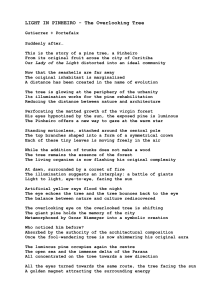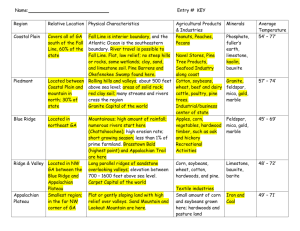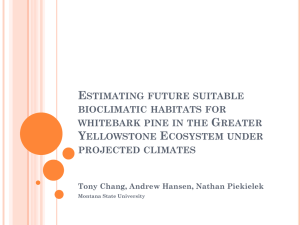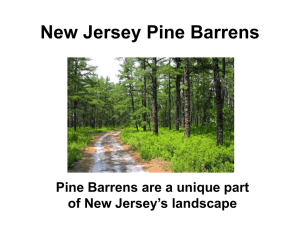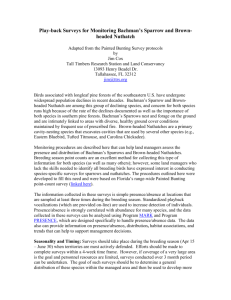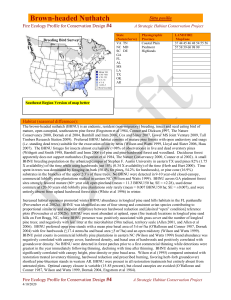Umbrella Rationale
advertisement
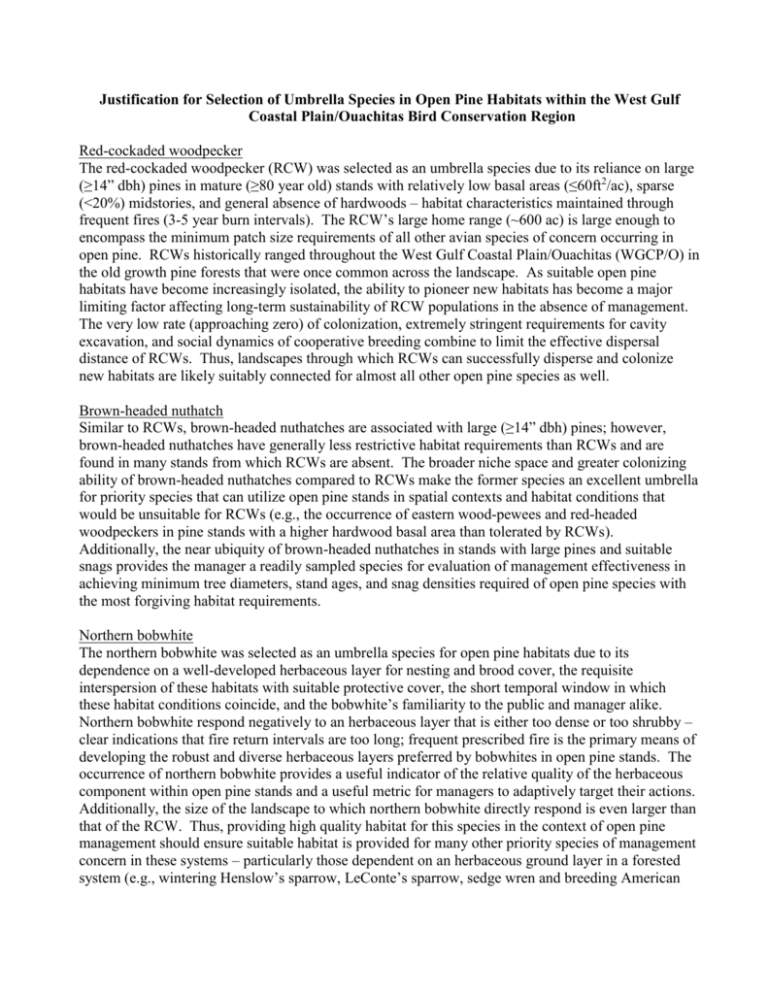
Justification for Selection of Umbrella Species in Open Pine Habitats within the West Gulf Coastal Plain/Ouachitas Bird Conservation Region Red-cockaded woodpecker The red-cockaded woodpecker (RCW) was selected as an umbrella species due to its reliance on large (≥14” dbh) pines in mature (≥80 year old) stands with relatively low basal areas (≤60ft2/ac), sparse (<20%) midstories, and general absence of hardwoods – habitat characteristics maintained through frequent fires (3-5 year burn intervals). The RCW’s large home range (~600 ac) is large enough to encompass the minimum patch size requirements of all other avian species of concern occurring in open pine. RCWs historically ranged throughout the West Gulf Coastal Plain/Ouachitas (WGCP/O) in the old growth pine forests that were once common across the landscape. As suitable open pine habitats have become increasingly isolated, the ability to pioneer new habitats has become a major limiting factor affecting long-term sustainability of RCW populations in the absence of management. The very low rate (approaching zero) of colonization, extremely stringent requirements for cavity excavation, and social dynamics of cooperative breeding combine to limit the effective dispersal distance of RCWs. Thus, landscapes through which RCWs can successfully disperse and colonize new habitats are likely suitably connected for almost all other open pine species as well. Brown-headed nuthatch Similar to RCWs, brown-headed nuthatches are associated with large (≥14” dbh) pines; however, brown-headed nuthatches have generally less restrictive habitat requirements than RCWs and are found in many stands from which RCWs are absent. The broader niche space and greater colonizing ability of brown-headed nuthatches compared to RCWs make the former species an excellent umbrella for priority species that can utilize open pine stands in spatial contexts and habitat conditions that would be unsuitable for RCWs (e.g., the occurrence of eastern wood-pewees and red-headed woodpeckers in pine stands with a higher hardwood basal area than tolerated by RCWs). Additionally, the near ubiquity of brown-headed nuthatches in stands with large pines and suitable snags provides the manager a readily sampled species for evaluation of management effectiveness in achieving minimum tree diameters, stand ages, and snag densities required of open pine species with the most forgiving habitat requirements. Northern bobwhite The northern bobwhite was selected as an umbrella species for open pine habitats due to its dependence on a well-developed herbaceous layer for nesting and brood cover, the requisite interspersion of these habitats with suitable protective cover, the short temporal window in which these habitat conditions coincide, and the bobwhite’s familiarity to the public and manager alike. Northern bobwhite respond negatively to an herbaceous layer that is either too dense or too shrubby – clear indications that fire return intervals are too long; frequent prescribed fire is the primary means of developing the robust and diverse herbaceous layers preferred by bobwhites in open pine stands. The occurrence of northern bobwhite provides a useful indicator of the relative quality of the herbaceous component within open pine stands and a useful metric for managers to adaptively target their actions. Additionally, the size of the landscape to which northern bobwhite directly respond is even larger than that of the RCW. Thus, providing high quality habitat for this species in the context of open pine management should ensure suitable habitat is provided for many other priority species of management concern in these systems – particularly those dependent on an herbaceous ground layer in a forested system (e.g., wintering Henslow’s sparrow, LeConte’s sparrow, sedge wren and breeding American kestrel [paulus subspecies]). Although it shares many of these characteristics with the Bachman’s sparrow, similar to the relationship of brown-headed nuthatches to RCWs, bobwhites will occur under broader habitat conditions than Bachman’s sparrow and thus provide a useful metric for managers in the absence of this latter species. Bachman’s Sparrow The Bachman’s sparrow was selected as an umbrella species because it is considered to be the quintessential open pine habitat grassland bird species. Its presence is indicative of a well-developed herbaceous layer that is only a product of frequent and consistent burns (≤3-year return interval). Furthermore, its poor dispersal ability necessitates high connectivity among open pine patches – more than required for nearly all other species. The co-occurrence of Bachman’s sparrow and red-cockaded woodpecker is characteristic of exceptional open pine habitat. The presence of Bachman’s sparrow in the absence of RCWs in pine stands is indicative of adequate fire but inadequate stand maturation. The inverse (i.e., presence of RCWs and absence of Bachman’s sparrows) indicates adequate stand maturity (and appropriately-sized pine trees) but burn intervals too lengthy to promote the requisite herbaceous layer needed by Bachman’s sparrows. In all cases, the co-occurrence of brown-headed nuthatches and northern bobwhites with these species should help managers evaluate the effectiveness of their management recommendations. Key habitat associations of potential umbrella species for open pine savanna in the West Gulf Coastal Plain/Ouachitas Bird Conservation Region. Modified and Accepted by Working Group 9-9-09. Habitat Factor Red-cockaded Woodpecker Umbrella Species Northern Brown-headed Bobwhite Nuthatch Bachman’s Sparrow Large patch size (ac) X Low pine basal area (ft2/ac) X X Low hardwood basal area (ft2/ac) X X X Low canopy cover (%) X X X X X X X Dense herbaceous ground cover (%) Short distance(km) to nearest patch (connectivity) X High snag density (snags/ha) High large (>14” dbh) pine density (pines/ac) Habitat heterogeneity X X X X

